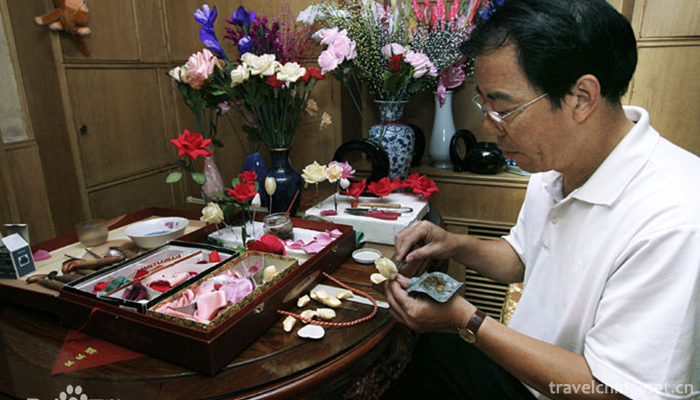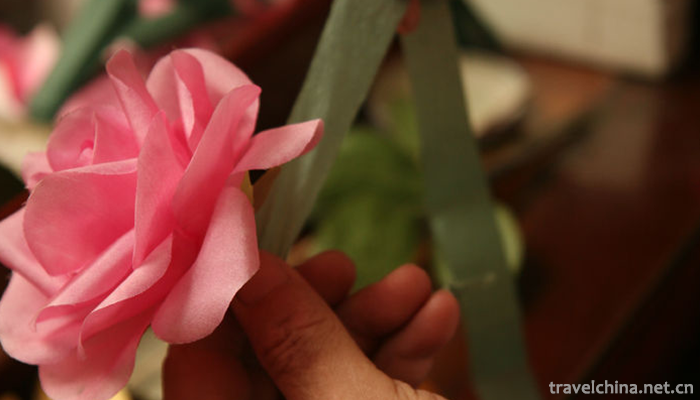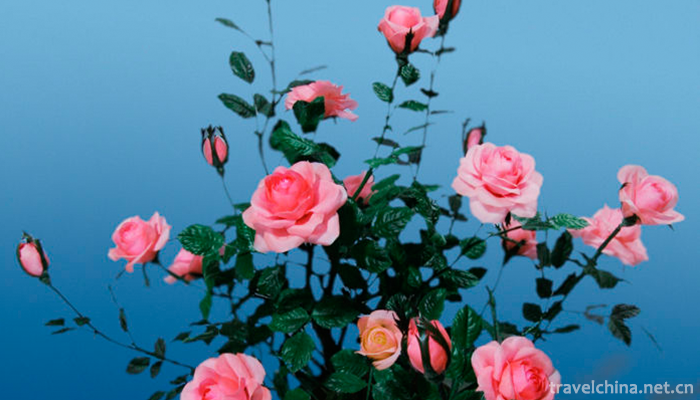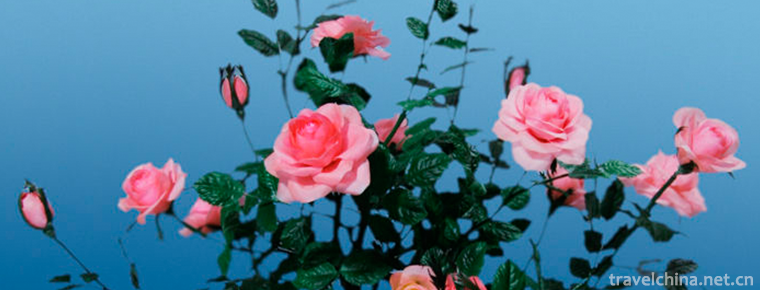Beijing silk flower
Beijing silk flower
Beijing silk flower, one of the traditional handicraft products in Beijing, also known as "Beijing flower", originated in Shenmuchang Street outside Chongwenmen in Ming Dynasty. It is a traditional art form made from silk, silk, satin and other raw materials through chisel, dyeing, gripping and accumulation.
Silk flower originated in Tang Dynasty and has a history of more than 1000 years. According to legend, there was a scar on the left sideburns of Empress Yang, the beloved concubine of Emperor Xuanzong Li Longji in Tang Dynasty. Every day, the palace girls were asked to pick flowers and wear them on the sideburns. But in winter, the flowers fade. A clever palace lady made false flowers out of ribs and silk for her princess. Later, this kind of "headdress flower" spread to the folk, prevailed for a time, and gradually developed into a unique style of handicraft "silk flower".
On June 7, 2008, Beijing silk flowers were listed in the second batch of national intangible cultural heritage list with the approval of the State Council.
Historical origin
Silk Flowers Made of Golden Bells
Beijing silk flower is famous both at home and abroad for its beautiful shape, exquisite workmanship, pleasant color, harmony, softness and vivid image.
According to the Qing Dynasty "Historical Relics of the Old Capital" records: "In Guangxu, there are people with the surname of Jin who make paper potted flowers and vases exquisitely, and people call them flowers and gold. So far, there is no right person with the surname of Jin in this industry." After several generations, the silk flower technique of Beijing was introduced into the Beijing Silk Flower Factory established in 1960 by the old artists such as Huaerjin and Huaerliu. Since then, the silk flower of Beijing has been sold well in more than 50 countries and regions in the world. In the largest Dutch flower market in the world, the silk flower of Beijing is juxtaposed with the fresh flowers and is in contention with each other. A basin of "10 Zhang Pearl Curtain" chrysanthemum produced by Jin Yulin, the fourth generation heir of "Huaer Jin", won the gold and silver prizes in the national arts and crafts hundred flower award industry evaluation. However, with the closure of Beijing Silk Flower Factory, only a few people have mastered silk flower skills, and the inheritance is facing a crisis. At that time, silk flower factories were mainly planned economy. Because of insufficient research on foreign markets and lack of grasp of changes in the international market, silk flower suddenly became unsalable since the 1990s.
The silk flowers made by famous artists in Beijing have won prizes at Panama World Expo. Nowadays, varieties have developed from dozens to more than 2000, including drama flowers, flower fibers, flower baskets, bonsai and so on. The production process of silk flower is: material selection, sizing, dyeing, pit petal, drying, setting, sticking, branching and other processes.
Silk flower culture
Beijing silk flower is made of high-grade pure silk, which can be divided into two categories: silk branch flower and silk potted flower.
Silk flower making
There are more than 8000 varieties. The pattern of silk branch varies from one type to another. The peony of the king of flowers is as beautiful as smoke; the rose of the queen in flowers is charming and beautiful; the autumn chrysanthemum with pride frost and fragrance is elegant and elegant; the Rhododendron in full bloom brings people into the mood of "a pile of spring smoke covered with red snow".
Silk flower, also known as "Jinghua Er", has a long history. According to legend, there is a scar on the left temple corner of Empress Yang, the favorite concubine of Emperor Xuanzong Li Longji in Tang Dynasty. Every day, the palace girls pick flowers and wear them on the temple corner. But in winter, the flowers fade. A clever palace lady made false flowers out of ribs and silk for her princess. Later, this kind of "headdress flower" spread to the folk, prevailed for a time, and gradually developed into a unique style of handicraft "silk flower". The picture of hairpin flowers and ladies by Zhou Fang, a famous painter in Tang Dynasty, vividly depicts the scene of women wearing flowers at that time. The silk flowers in Beijing began in the Ming Dynasty. By the Qing Dynasty, silk flowers were more prevalent. There were various workshops set up by the Imperial Palace in the Qing Dynasty, specializing in producing various kinds of flowers for banquets and decorations, such as silk, silk, paper, grass and rice. Liu Hengyuan, a famous folk artist in the Qing Dynasty, made the silk flower "Huaer Liu", which won an award at Panama World Expo.
The Waihua Street in Chongwenmen, Beijing, was the gathering place for the production and sale of "Jinghua'er" at that time. More than 100 years ago, there were numerous flower-making workshops and famous flower-making teachers gathered here. "Yan Jing Sui Shi Ji" contains: "From the first month of Chongwenmen to the east, there are markets on the fourth, fourteenth and twenty-fourth day of junior high school. The so-called flower market is a paper flower put on by women, which is also a flower from time to time. Flowers can be mixed up with grass, silk, twigs and wrestling. In the month of Mengchun in Beijing, children cut colorful flowers or insects and so on. They clamoured day by day, that is, the so-called "costume" in ancient times is also the origin of silk flowers.
Inheritance significance
In 2007, Beijing silk flower was listed in the second batch of Beijing intangible cultural heritage list. In 2008, Beijing silk flowers were selected into the Second National List of intangible cultural heritage with the approval of the State Council. In 2009, Jintieling was named the representative successor of national non-heritage projects. In 2010, Xu Wenjing was named the representative successor of district-level non-heritage projects.




-
1.Xitang Ancient Town Tourist Scenic Spot
Xitang Town, belonging to Jiashan County, Jiaxing City, Zhejiang Province, is located at the junction of Jiangsu, Zhejiang and Shanghai. It has an ancient name of Xietang
Time 2018-12-07 -
2.Daqing Oilfield History Exhibition Hall
Daqing Oilfield History Exhibition Hall is the first original Memorial Hall in China with the theme of petroleum industry, and it is a cultural relic protection unit in Heilongjiang Province.
Time 2019-01-07 -
3.Hengshan Scenic Area
Hengshan Scenic Area, located in Nanyue District of Hengyang City, is a holy place of Quanzhen sect, the mainstream Taoist religion, with an elevation of 1300.2 meters. Because the climate conditions
Time 2019-01-16 -
4.Li Zhuang ancient town
Lizhuang, an ancient town precipitated by cultural and historical relics, is an ancient town that tells stories and vicissitudes of the Anti-Japanese War. It is an ancient town that reflects Chinese t
Time 2019-01-29 -
5.The tru Valley
Turugou is located in Liancheng Forest, Yongdeng County, 160 kilometers northwest of Lanzhou City. It belongs to the eastern foot of Qilian Mountains.
Time 2019-02-22 -
6.Zhuquan Village Tourist Resort
Zhuquan Village Resort is located in the north of Yinan County, Shandong Province, 12 kilometers away from the county. It was called Quanshangzhuang in Yuan and Ming Dynasties and was renamed Zhuquan
Time 2019-03-21 -
7.Sacrifice Aobao
Aobao sacrifice is a traditional custom of Mongolian people, and one of the manifestations of prairie people's natural worship. Xilinguole League is a relatively complete
Time 2019-05-05 -
8.Laozi Shandong Province
Shandong Laozi is a traditional opera art form which spreads in Shandong Province. It evolved from the ancient "lotus flower falls". Laozi instruments are mainly cymbals (commonly known as G
Time 2019-06-13 -
9.The Legend of Shun
Shun was born in Zhufeng Village, Yongji County. His surname is Yao and his name is Chonghua because of his double pupils. Soon after his mother gave birth, he died. His father married a stepmother an
Time 2019-06-16 -
10.Golden Gong dance of Yao nationality
In November 2014, the Golden Gong dance of Yao nationality declared by Tiandong County of Guangxi Zhuang Autonomous Region was listed in the fourth batch of national intangible cultural heritage list
Time 2019-07-11 -
11.Diagnosis of Traditional Chinese Medicine
Diagnosis of traditional Chinese medicine, one of the traditional Chinese medicine, is declared by the Chinese Academy of Traditional Chinese Medicine, one of the national intangible cultural heritage
Time 2019-08-10 -
12.Mahu scenic spot
Mahu scenic area, located in Leibo County, Liangshan Yi Autonomous Prefecture, Sichuan Province, covers an area of 100 square kilometers. The scenic spot is composed of Mahu lake, Jinshajiang Valley and primitive dense forest.
Time 2020-10-16